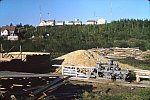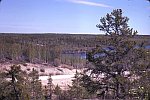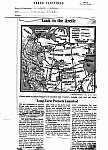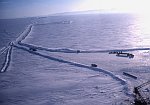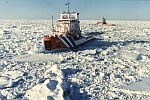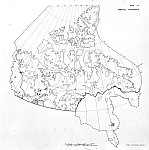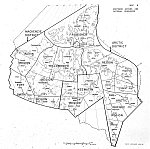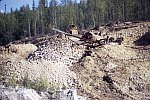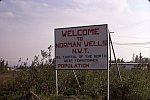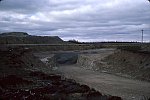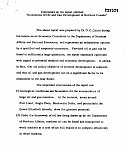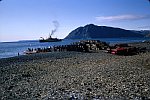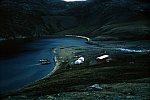Resources
Author: Tom Novosel Page 1 | Page 2 | Page 3
The first half of the twentieth century did not see the Canadian government develop any specific northern strategy towards resources. Resources from the provincial norths, such as forestry for the pulp and paper industry, minerals, and water for hydro-electric purposes, helped establish and diversify industrial development, particularly in the southern portions of Canada’s provinces, mainly Ontario, Quebec, and British Columbia. The southern portions of the Prairie Provinces remained dominantly agricultural and really only came to understand the problems of limited economic diversification after the devastating effects of the Great Depression in the 1930s. The Maritime Provinces continued their reliance on staples industries such as fishing. The Territorial norths continued to see sporadic prospecting, exploration, and speculation on its resource wealth, but no concrete plans regarding resources were ever set in motion. As historian Morris Zaslow explains in regards to northward expansion, “the ‘discovery’ phase was largely completed except for parts of the Arctic Archipelago, while much of the Subarctic was being occupied by modern industries striving to exploit the agricultural, forestry, hydro-electric, and mineral resources of the land.”
Coming after the Great Depression of the 1930s, World War Two helped revitalize the Canadian economy. The paper “The Role The North Should Play In Canadian Development,” outlining Diefenbaker’s Conservative government’s development strategy, states that “the war had given Canadian business increased size and confidence. There was a growing willingness to take risks in exploration and development [but] also a growing concern over the extent of foreign ownership and control.” The economy of the United States grew by leaps and bounds after the war and would need resources to sustain its industrial needs of the future.
While subsequent Liberal administrations after the war took a more interventionist approach to Canada’s economy, it was Diefenbaker’s Conservative government that realized it had to take greater initiative in the north by gaining more ownership and control of its resources. The government also realized that some private capital was still necessary for resource development and hence furthered tax reliefs, and assistance grants; the most common recipients were the oil, gas, and mining industries. Diefenbaker’s government announced its “national development program”, which consisted of developing the country’s energy resources; being more conscious of conservation, which at this time meant what was the best use of Canada’s resources; and “to find out what we had, where and how much.” As historian Morris Zaslow states, “development of the country’s natural resources continued to be the mainspring of national growth, as it had been from earliest times…and after the Second World War, apparent limitless markets, innovative technology, and big-spending governments sustained expansion based on natural resource exploitation until most of the national endowment was brought under development.”
Diefenbaker’s program detailed resource site developments, such as oil at Frobisher Bay in the high-arctic region of the NWT, river, power, and nuclear, but it also contained probably his best known northern vision, the “Roads to Resources” initiative. While former Prime Minister Robert Borden first pronounced a Roads to Resources idea to parliament in 1911, which was subsequently dismissed; it is John Diefenbaker’s “Roads to Resources” program that is the most recognized governmental venture specifically dealing with northern resources. Under this program a vast amount of roads and railways were built by both provincial governments for their provincial norths and the federal government building mainly for the Yukon and Northwest Territories in order to open up the northern regions and create easier access to its resources for development possibilities. For example, one spin-off of the roads to resources program was the “Forest Access Roads” initiative that inevitably opened up further access and development for the forest industry, particularly the pulp and paper industry, as evidenced in Saskatchewan, and helped further establish sawmills in the Northwest Territories.
At the same time it was important for roads and railway links in the provincial north to be easily accessible and connected to transportation routes, including waterways, with those already in existence or in planning stages in the Yukon and Northwest Territories. One example of the provincial north-northern Territories transportation connection is the discussion surrounding northern Alberta’s Athabasca Tar Sands, Peace River, and Great Slave Lake in the Northwest Territories. Another example is the government’s initiative to build over 1400 miles of roads in the Territories, including bridges, and renovating the CANOL Road, which was a World War Two project originally meant to service a pipeline running from Norman Wells on the Mackenzie River to a refinery at Whitehorse, but later meant to assist in mineral exploration in the same area. The common theme here is developing transportation routes that are most economical for resource exploitation.
However, not all roads to resources initiatives were welcomed. In a memo titled “The Importance of Mining Roads” developer and prospector Cyril T. Young of Toronto suggests there can be “too much vision in developing far distant Arctic resources when (roads to resources) should apply mainly to developing areas within the reach of labour…between the sections that have pulp and paper mills and mining as well as power development.” What is evident here is the difference infrastructure can play in the provincial north, where roads and railways are more feasible, in regards to constructing sustainable infrastructure in the Arctic tundra. But visionary transportation methods such as commercial airliners or ice roads over frozen rivers and lakes and ice-breakers through these same systems, have made resources accessible wherever they may be in the Arctic. To ensure accessibility and progress in further prospecting and exploring all northern regions, the government, therefore, has been required to overcome the chief problem of better transportation infrastructure to facilitate economic expansion, production, and promote the expansive northern resource economy.
The Canadian government’s desired economic expansion and development of the Northwest Territories and Yukon has always concerned itself with, and depended largely upon, their mineral resources and more recently their oil and gas reserves. Prior to World War Two, exploration and discovery was minimal, the most famous finds being the Klondike Gold Rush of the late 1890s and the Norman Wells oil patch in 1920, but the regions have always been part of a continuous myth, and sometimes qualified belief, that the Arctic contains an unlimited resource potential. Government and industry have traditionally sought after and discovered metals and minerals including ore, lead, zinc, copper, nickel, uranium, diamonds, and gold.
The resource potential of oil and gas has sparked the most recent interest. The Arctic Islands, Baffin Island, and the Mackenzie District in the Northwest Territories have received exceptional interest in these development possibilities, along with oil and gas potential in seabeds and subsoils off of Canada’s arctic shores. One example of reports suggesting the Arctic’s oil and gas potential came from “Economics of Oil and Gas Development in Northern Canada” by David Quirin, commissioned by the Diefenbaker government, in which he suggested “Canada could become a major world oil power which would benefit not only the North but the overall economy.” Today, with increased technology and modernization, oil and even further mineral exploration has continued into the far reaches of the Arctic north.
Mineral and oil and gas resources have also been part of the development strategies of the provincial norths. While southerners have tended to neglect the overall political, economic, and social aspects of the northern inhabitants, some have been more curious. In a personal letter to Prime Minister Diefenbaker, then fourteen year-old G. Adamyk wondered about unemployment, foreign control of resources, and why the Canadian government “doesn’t put to use the millions of dollars worth of resources and minerals in Labrador, Quebec, Manitoba, and British Columbia.” It goes without saying that subsequently millions of dollars worth of resource extraction has occurred all throughout Canada’s provincial norths; and as historians Ken Coates and William Morrison state, “the northern regions of the provinces have been rendered into internal colonies, their resources deemed to be available primarily for the benefit of the south, with massive transfers of wealth out of the region and with comparatively little attention being paid to northern inhabitants and to the long-term prospects of northern society.”
Numerous northern development conferences involving the federal government, local communities, and private businesses have taken place throughout Canada’s history of resource exploration. One common theme is viewing the north as the “last frontier,” such as existed in 1958 at a conference in Edmonton, Alberta. However, what is also implicit in many of these conferences is that although they intend to bring industry to northern regions, which invariably bring jobs and some businesses to the areas, they also intend to meet requirements (such as energy and hydro-electricity) for southern markets and specific industries in the provincial norths (such as mining and pulp and paper). While the establishing communities in the northern frontier regions of Canada have been successful, many of them are single-industry resource towns also, the term “frontier” tends to suggest an open and uninhabited country. As historian Morris Zaslow continues, “since the frontier districts failed to achieve as full a development as the metropolitan heartlands from which they sprang, they also proved unable to emancipate themselves from heartland economic, social, and political hegemonies.” The term hegemony here suggests that northern regions are unable to control resource and economic development taking place in their areas.


